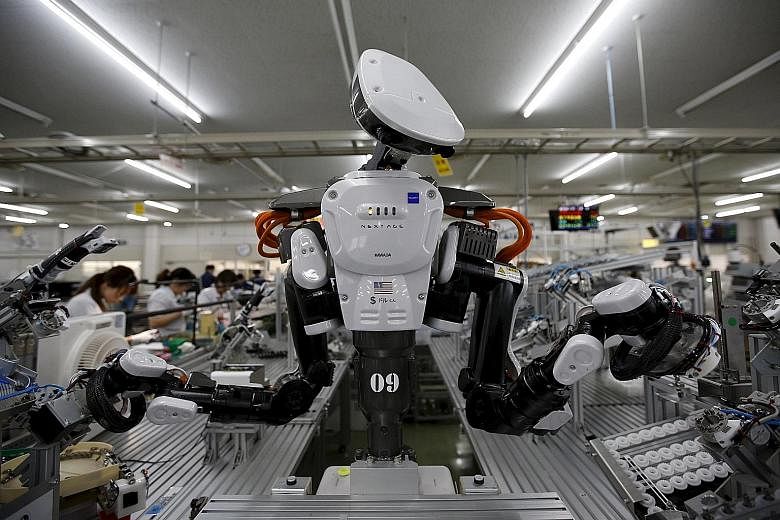TOKYO • Japan is looking to reboot.
As part of Prime Minister Shinzo Abe's drive to reinvigorate the world's third-largest economy, the nation is striving to accelerate innovation ahead of hosting the Olympics in 2020.
Support is being rolled out for joint projects between the public and private sectors, such as a push to put driverless cars on the road and efforts to utilise leading-edge technology based on robotics.
Mr Abe aims to boost investment in research and development (R&D) as a proportion of gross domestic product to 4 per cent by the close of the fiscal year ending March 31, from 3.75 per cent two years ago. By early 2018, the government wants Japan to be the top-ranked nation for innovation.
There has been progress in the aviation and healthcare industries. The first passenger plane developed in Japan in more than half a century has made its debut flight, while Professor Takaaki Kajita shared last year's Nobel Prize in physics. Fujifilm is testing ambitious ideas for stem cells capable of regenerating tissue in the human body.
At the height of its industrial prowess, Japan set the pace for global innovation, but its recent record has been mixed. Stagnating economic growth and spiralling deflation have weighed on corporate confidence and planning.
Where Japan once led in fields like home entertainment, today's smartphone and Internet era belongs to non-Japanese brands such as Google, Apple and Samsung.
A Japanese think-tank and researchers at Britain's Oxford University have found that artificial intelligence or robots would be capable of taking over jobs done by half of Japan's workers in 10 to 20 years, Kyodo news agency reported.
The Nomura Research Institute and the Oxford Martin Programme on Technology and Employment examined the potential impact of computerisation on 601 types of jobs which are currently done by 42.8 million people, and found that 49 per cent of workers in Japan could be replaced by computers.
Similar studies show the figure to be 47 per cent in the US and 35 per cent in Britain. These jobs include administrative workers, taxi drivers, cashiers and security guards.
Japan does retain its edge in the car industry. Nissan in November displayed a concept car with a message-flashing windshield, joining Honda and Toyota in exhibiting vehicles with autonomous modes capable of changing lanes.
"Toyota and other existing car companies still have a huge advantage in this industry in terms of market share, technologies and data," said Mr Tak Miyata, founder of Scrum Ventures, which funds startups.
But Japan's competitors are accelerating their efforts. China and South Korea have increased R&D spending at a faster pace than Japan in recent years, according to the Organisation for Economic Cooperation and Development.
Expenditure on R&D as a proportion of gross domestic product in China rose to 2.08 per cent in 2013 from 0.9 per cent in 2000, while the figure in South Korea increased to 4.15 per cent in 2013 from 2.18 per cent in 2000.
The biggest challenge is to obtain funding for the right kind of programmes, said Mr Hidenobu Tokuda, senior economist at the Mizuho Research Institute in Tokyo.
"There's little need for Japan to increase the amount of R&D spending further," he said. "Rather, Japan has to improve the quality of its R&D expenditure."
BLOOMBERG

